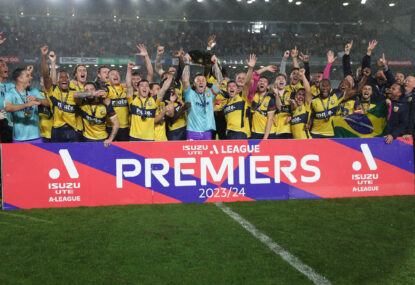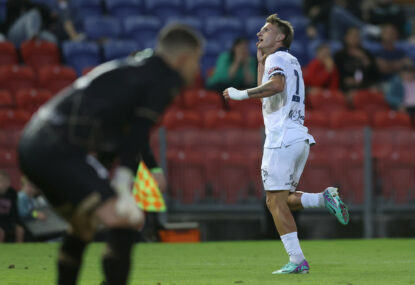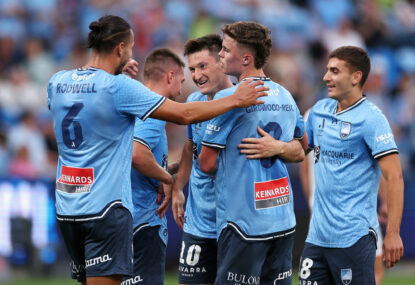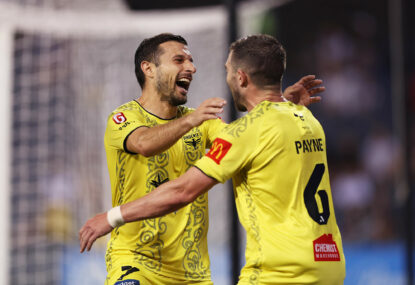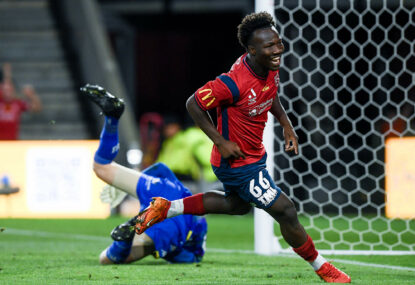
Adelaide United's Sasa Ognenovski beats Masato Yamazaki of Gamba Osaka. AAP Image/Rob Hutchison
What a contrast between Adelaide United’s and Melbourne Victory’s Asian Champions League campaigns. With Melbourne Victory failing to make an impression in their group, with ambivalence the prevailing attitude from Kevin Muscat and co, Adelaide United went down battling, having yet again challenged Asia’s best.
Circumstances obviously favoured United, with their woeful performances in the A-League ironically assisting their ACL campaign.
With the ACL proving to be an annoyance for the Melbourne Victory as they struggled to balance their Asian commitments with their A-League finals campaign, with a growing injury tool worsening the situation, Adelaide could focus exclusively on the ACL, impressively bolstering their squad in the process.
As the Victory finished last in Group E with only one victory, Kevin Muscat’s now infamous comments to Fox Sports on his thoughts on the ACL left a bitter taste.
“To be honest, playing in Asia, is not all that enjoyable,” he said.
“People going down left, right and centre, stalling for time, it’s not that enjoyable playing in the Champions League.
“I think it’s evident for people to see. Being involved in it and watching it I can understand why people don’t come and watch.”
Enjoyable or not, Muscat and many others in Australian football are missing the opportunity presented by the ACL for A-League clubs: crucial development.
Playing the best in Asia, particularly K-League and J-League sides, forces Australian teams to lift their game to the higher technical standard of their opponents.
Asian sides are often much better on the ball, able to maintain control in the midfield and build an attack from the back, without the impatience of Australian sides.
Too many of the A-League clubs go into Asia with their A-League mindset, failing to adapt to the differences in the Asian game, and they are inevitable caught out.
When they don’t adapt to this and persist with their A-League playing mentality, they are often outclassed, as was witnessed when the seemingly ambivalent Melbourne Victory were embarrassed by Kawasaki Frontale.
And it’s no surprise that the tactics used in Asia frustrates a player of Muscat’s ilk, who typifies the A-League’s aggressiveness.
But Adelaide learnt from their run to the ACL final two seasons ago that they need to adapt an Asian mentality when playing in the ACL, and it’s no surprise they have been able to go far in the competition this season (perhaps just as impressive as two seasons ago as they’ve rebounded from a wooden spoon in the A-League) off the back of the performances of players such as Matthew Leckie, Fabian Barbiero, Marcos Flores and Cassio, who are adept at holding onto the ball and creating opportunities through the midfield.
The ACL has forced the best out of Adelaide United and its players, raising them to a higher technical standard that they must now maintain in the A-League next season.
For young players such as Leckie, Barbiero and Michael Marrone, playing in Asia is an invaluable education in different football cultures and playing styles, which will serve them very well as their careers progress.
This is why Australian clubs must embrace the ACL. It should be seen as a highly valued testing ground and developmental exercise, not just as a financial windfall.
As for the Reds, if they can retain Flores, Sergio van Dijk and Adam Griffiths going forward, they will be well on the way to returning to the forefront of the A-League.
They were a club transformed in the ACL and that progress must continue into next season.
And their performances should act as a lesson to other clubs on the importance of the ACL, not just in terms of on-field performances.
It’s little wonder Adelaide United has the best retention rates in terms of A-League crowds when compared with results.
Their Asian adventures have given the club an extra selling point to the South Australian community.
They’ve proven that even though having standalone matches outside the A-League season, spread over a number of weeks in the midst of the AFL season, against players “going down left, right and centre, stalling for time” may be far from ideal for marketers of the game in Australia, that the ACL can be embraced by audiences in this country.
The whole of the Australian football community should be grateful and proud of Adelaide United’s ACL adventure, showing why Australian clubs must embrace it; not treated with contempt.































































































